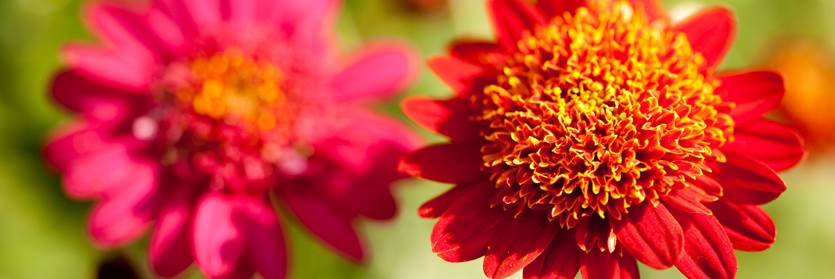Inside The New York Botanical Garden
Science
Posted in Science on August 17 2010, by Plant Talk
View the Diversity, Distribution, and Status of 45 Species
 |
Brian M. Boom, Ph.D., is Director of the Caribbean Biodiversity Program at The New York Botanical Garden.
|
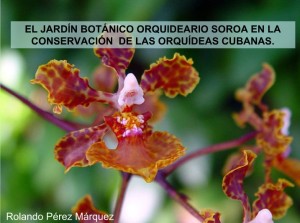 Regular readers of Plant Talk may recall the post I co-wrote during The Orchid Show: Cuba in Flower in March that highlighted the long history and current program of plant exploration in Cuba by scientists of The New York Botanical Garden. Orchids are one of the most diverse of flowering plant families in Cuba, where some 497 species and varieties are known, of which about 181 (36%) are endemic to the island.
Regular readers of Plant Talk may recall the post I co-wrote during The Orchid Show: Cuba in Flower in March that highlighted the long history and current program of plant exploration in Cuba by scientists of The New York Botanical Garden. Orchids are one of the most diverse of flowering plant families in Cuba, where some 497 species and varieties are known, of which about 181 (36%) are endemic to the island.
Cuban botanists presently consider that at least 32 species of orchids are threatened due to various factors such as habitat modification and climate change. However, the process of evaluating at-risk species in Cuba, and elsewhere, is far from complete. The Botanical Garden is currently developing a new method to evaluate at-risk species much more rapidly than has been done traditionally so that we can get a more complete view of the status of plants in Cuba and throughout the Caribbean. (See page 6 of Garden News.)
Read More
Posted in Exhibitions, Science, The Edible Garden on June 15 2010, by Plant Talk
Discuss Research, Learn About Plant World in Casual Setting
During The Edible Garden, which opens this weekend and runs through October 17, visitors will have the opportunity to gather with some of the Botanical Garden’s scientists in a casual setting known as Café Scientifique. Begun in Leeds, England, in 1998, Café Scientifique is an informal meeting that brings together the public and scientists to discuss science in familiar terms.
Today the Café Scientifique idea has spread well beyond the borders of the United Kingdom. The Garden has presented these in the past, and this summer and fall will host 18 such events over four weekends, with the first set scheduled this Saturday and Sunday at 11 a.m. and 3 p.m. both days in the Garden Cafe.
Garden research staff, postdoctoral fellows, and graduate students will talk about the research and conservation they pursue worldwide—from Latin America to Micronesia and our own backyard—and share with those who attend a greater understanding of the plant world and the efforts under way to conserve plant diversity. They will discuss a wide variety of research topics, such as the exploration of poorly known regions to discover, describe, and name new species of plants; how various plant groups are related and their evolutionary history; and the genetic basic for why plants have different structural features.
Read More
Posted in Science on June 2 2010, by Plant Talk
 |
Wayt Thomas, Ph.D., is the Elizabeth G. Britton Curator of Botany in the Institute of Systematic Botany. |
Editor’s note: Botanical Garden scientist Dr. Wayt Thomas has been filing reports from the field in northeastern Brazil, where he has studied the flora of the Atlantic coastal forest for 20 years. Read his earlier posts from this trip.
Wednesday, 12 May (Continued): We went back to Serra Grande and had dinner with Daniel; we went to the central plaza in town and had acarajé, a Bahian specialty with African origins, and not for the diet conscious. It is a dumpling made of chickpea meal deep-fried in dendê (African oil palm) oil. After it is fried, it is split open and slathered with a combination of other Bahian specialties, including dried shrimp, salad, vatapá (another dish of African origin made of bread pudding with shrimp, coconut milk, peanuts and cashews), and hot pepper paste.
Thursday, 13 May: Today we started for the town of Jequié, but with a planned detour on the way. Leaving Serra Grande, we headed north toward the beach resort town of Itacaré, and then over the new bridge crossing the Rio de Contas (Pebble River). We turned east toward the Marau Peninsula, an area of intense beachfront development and, consequently, increasingly threatened native vegetation. The sandy savannas near the coast are called restingas and harbor a fascinating array of species, some also found in Brazil’s central highlands, others unique to Marau. In some cases, the restinga sands support forests—these, too, are home to fascinating species such as Griffinia espiritense, a lily with beautiful green-and-pink mottled leaves, or the strange Anthurium bromelicola, a slender vine that grows only out of the center of terrestrial tank bromeliads.
The town of Jequié is at the western edge of the coastal forest, at the boundary between forest and dry thorn scrub known as caatinga (it means “white forest,” which is what it looks like when it has lost its leaves). One of our collaborators, Dr. Guadalupe Macedo, is a professor at the State University of Southern Bahia, in Jequié. We drove the four hours west from Marau to Jequié to meet with her to discuss our joint project.
Read More
Posted in People, Science on May 25 2010, by Plant Talk
Wayt Thomas Collaborating on Research in Tropical Forests
 |
Wayt Thomas, Ph.D., is the Elizabeth G. Britton Curator of Botany in the Institute of Systematic Botany. |
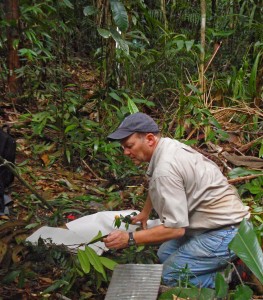 I’ve been studying the flora of the Atlantic coastal forest in northeastern Brazil for 20 years. These forests are one of the world’s “biodiversity hotspots” because of the heavy deforestation, high species diversity, and large number of species that occur nowhere else. Much of my work has been focused on the forests of southern Bahia, near Ilhéus, but I recently was awarded a grant from the National Science Foundation to study the forests farther to the northeast.
I’ve been studying the flora of the Atlantic coastal forest in northeastern Brazil for 20 years. These forests are one of the world’s “biodiversity hotspots” because of the heavy deforestation, high species diversity, and large number of species that occur nowhere else. Much of my work has been focused on the forests of southern Bahia, near Ilhéus, but I recently was awarded a grant from the National Science Foundation to study the forests farther to the northeast.
As you read this, I am again in Brazil, having left New York on May 9. The purpose of my trip is several-fold: to check up on the field work of my student, Daniel Piotto, near Ilhéus, Bahia; to meet with professors at the State University of Santa Cruz in Ilhéus; to travel inland to Jequié, Bahia, to meet with a collaborator at the State University of Southern Bahia; to visit the Guaribas Biological Reserve in Paraíba; and to organize the newly funded project with my Brazilian collaborators, an essential element in field research.
I will file reports such as this one and photos from Brazil as access to the Internet on my end allows.
Read More
Posted in Science on May 18 2010, by Plant Talk
Garden Scientists Explore Biodiversity in Australia, Brazil, and Colombia
As environmental pressures increasingly put biodiversity at risk, one of the Garden’s most important goals is to lead in the effort to document every plant and fungal species on Earth. Garden scientists conduct research around the globe. Here are three recent reports from the field.
Roy Halling Returns to Fraser Island, Australia
In late March, Roy Halling, Ph.D., a specialist in mushrooms, continued his survey of macrofungi on Fraser Island, the largest of the world’s sand islands and a World Heritage Site off the east coast of Queensland, Australia. There he 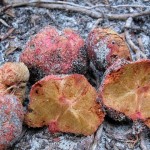 and Nigel Fechner, a Senior Botanist at the Queensland Herbarium in Brisbane, found an undescribed genus of “false-truffle,” previously known only from Cape York, the northernmost part of Queensland. They discovered the fungus (pictured), about the size of a golf ball, protruding from a sand bank near Lake McKenzie. Scratching with a truffle rake in the sand and litter under a gum tree (Eucalyptus signata), they unearthed more of the bright red fungus. Like the truffle of commerce, this fungus has a strong penetrating odor, one of the key factors in attracting marsupials, which eat the fungus and disperse the spores in their scat.
and Nigel Fechner, a Senior Botanist at the Queensland Herbarium in Brisbane, found an undescribed genus of “false-truffle,” previously known only from Cape York, the northernmost part of Queensland. They discovered the fungus (pictured), about the size of a golf ball, protruding from a sand bank near Lake McKenzie. Scratching with a truffle rake in the sand and litter under a gum tree (Eucalyptus signata), they unearthed more of the bright red fungus. Like the truffle of commerce, this fungus has a strong penetrating odor, one of the key factors in attracting marsupials, which eat the fungus and disperse the spores in their scat.
The real gems for Halling on this trip were finding an exquisite species of Strobilomyces and a first report from Australia of a Heimioporus japonicus. This is the second known instance of a species in that genus in Australia.
Wayt Thomas Joins Partners in Brazil
Wayt Thomas, Ph.D., studies tropical American forests, especially the Atlantic forests of Brazil, one of the world’s biodiversity “hotspots.” He spent February in Brazil, working with colleagues from the Federal University of Paraiba and four other Brazilian universities studying the plants found in one of the most critically endangered rain forests in the world.
Two of the reserves Thomas visited on this trip protect submontane forests—moist forests at elevations of 1,300–2,600 feet. These two reserves are home to some of the world’s rarest birds, including the Alagoas Antwren, the Alagoas Foliage-gleaner, the Alagoas Tyrannulet, and the Orange-bellied Antwren. By comparing submontane forests with similar avifauna, he hopes to predict the occurrence of these rare birds in other areas.
Douglas Daly Travels to Colombia
Douglas Daly, Ph.D., returned to Colombia in January for the first time in 20 years to pursue his studies of the tropical tree family Burseraceae. He consulted eight herbaria in three cities and identified and annotated some 4,000 Burseraceae specimens in order to complete his treatment of the family for Colombia’s national flora checklist. Daly was able to secure permission to work in two localities on the western side of the Andes where small areas of primary forest remain. Although Colombia was in the grip of a severe drought, he collected more than 16 distinct species of Burseraceae, two of which he had never seen before, a tribute to the dizzying plant diversity of Colombia.
Posted in Gardening Tips, People, Science on April 5 2010, by Sonia Uyterhoeven
 |
Sonia Uyterhoeven is Gardener for Public Education. For hands-on demonstrations and orchid tips, join her in the Conservatory’s GreenSchool every Saturday and Sunday at 2 p.m. throughout The Orchid Show. |
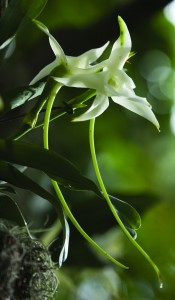 One of the joys of working at The New York Botanical Garden is that you are surrounded by experts, enthusiasts, and curious minds. The Garden has a large team of talented research scientist who convene on a regular basis to share their work and interests in an in-house seminar series.
One of the joys of working at The New York Botanical Garden is that you are surrounded by experts, enthusiasts, and curious minds. The Garden has a large team of talented research scientist who convene on a regular basis to share their work and interests in an in-house seminar series.
Recently, we were spoiled with the presence of Robbin Moran, Ph.D., Mary Flagler Cary Curator of Botany, who specializes in the study of tropical ferns and lycophytes. But rather than his usual discussions of systematics and pteridophyte matters, he shared with us his recreational reading over the past year: the six books that Charles Darwin wrote after his publication of On the Origin of Species that pertain specifically to the study of botany. Those of you who attended our exhibition Darwin’s Garden: An Evolutionary Adventure in 2008 will remember that the celebrated naturalist was an avid experimenter and committed to the study of botany.
Read More
Posted in Science on April 1 2010, by Plant Talk
Garden Scientist Talk Reveals What’s New in Northeastern N. America
 Robert Naczi, Ph.D., is Curator of North American Botany.
Robert Naczi, Ph.D., is Curator of North American Botany.
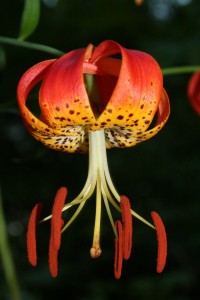 Since its founding in 1891, The New York Botanical Garden has been a center of scientific study of the plant life of northeastern North America. Generations of Garden scientists have been active in writing books that aid in the identification of plants that grow spontaneously within this vast region, which extends from Nova Scotia west to Minnesota, and south to Virginia and northern Missouri (more than 25 percent of the area of the contiguous United States). This region hosts about 5,000 species, including many that are essential for a healthy environment, economically important, and quite beautiful, such as Lilium superbum (turk’s-cap lily, pictured here).
Since its founding in 1891, The New York Botanical Garden has been a center of scientific study of the plant life of northeastern North America. Generations of Garden scientists have been active in writing books that aid in the identification of plants that grow spontaneously within this vast region, which extends from Nova Scotia west to Minnesota, and south to Virginia and northern Missouri (more than 25 percent of the area of the contiguous United States). This region hosts about 5,000 species, including many that are essential for a healthy environment, economically important, and quite beautiful, such as Lilium superbum (turk’s-cap lily, pictured here).
The most recent book on the subject is Manual of Vascular Plants of Northeastern United States and Adjacent Canada by Henry A. Gleason and Arthur Cronquist (1991, The New York Botanical Garden Press; also available electronically). Professors, students, land managers, conservationists, and gardeners universally regard it as an indispensable reference. Advances in botany since 1991 have made a major revision of the Manual an obvious necessity.
Read More
Posted in Science on March 11 2010, by Plant Talk
A Century of Plant Exploration and Research
 |
 |
Brian M. Boom, Ph.D., is Director, Caribbean Biodiversity Program, and Melissa Tulig, is Associate Director of the Herbarium at The New York Botanical Garden.
|
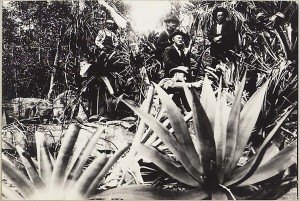 The Orchid Show: Cuba in Flower in the Enid A. Haupt Conservatory provides an excellent occasion to draw attention to the Botanical Garden’s long history of plant exploration in Cuba and the Garden’s current scientific activities on the largest and most biologically diverse island in the Caribbean.
The Orchid Show: Cuba in Flower in the Enid A. Haupt Conservatory provides an excellent occasion to draw attention to the Botanical Garden’s long history of plant exploration in Cuba and the Garden’s current scientific activities on the largest and most biologically diverse island in the Caribbean.
Beginning in 1903 and as recently as October 2009, the Garden has collaborated with Cuban botanists and institutions in documenting and studying the Cuban flora, collecting more than 20,000 specimens on 23 expeditions. The Garden’s research in Cuba is active and ongoing.
(The black-and-white photo above from the Mertz Library Archives is from an expedition to the Isle of Pines in Cuba led by the Garden’s founder Nathaniel Lord Britton in 1916. The photo below, by Garden scientist Fabián A. Michelangeli, Ph.D., is from the most current expedition and shows Garden scientist Wayt Thomas, Ph.D., at left, with his Cuban student Waldo Bonet collecting sedges.)
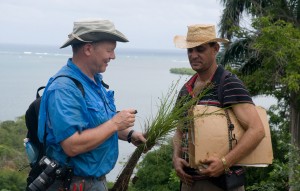 One good way to tell this story of more than a century of plant exploration in Cuba is through the more than 12,500 digitized specimen records currently available via the Garden’s C.V. Starr Virtual Herbarium. Some newly created Web features allow easy access to these data, and we recommend trying the following to explore the Garden’s history in Cuba and some of the plant diversity on the island as told by the specimens.
One good way to tell this story of more than a century of plant exploration in Cuba is through the more than 12,500 digitized specimen records currently available via the Garden’s C.V. Starr Virtual Herbarium. Some newly created Web features allow easy access to these data, and we recommend trying the following to explore the Garden’s history in Cuba and some of the plant diversity on the island as told by the specimens.
Read More
Posted in Science on February 24 2010, by Plant Talk
Staff Preserve More Than 35,000 Plants Each Year
 |
Lisa Vargues is Curatorial Assistant of the Herbarium. |
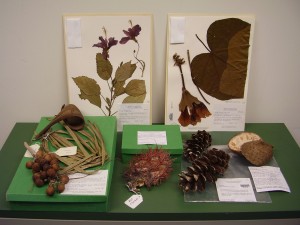 Adjacent to The New York Botanical Garden’s Library building stands a 70,000 square-foot treasure chest: the William and Lynda Steere Herbarium. This “library” of over 7.3 million preserved and filed plant specimens is the largest in the Western Hemisphere and considered a crown jewel in the world of botanical research. Roughly 35,000–40,000 specimens arrive here annually from around the world, through gifts, exchanges, and staff collections, and are preserved through a careful process that has not changed for centuries.
Adjacent to The New York Botanical Garden’s Library building stands a 70,000 square-foot treasure chest: the William and Lynda Steere Herbarium. This “library” of over 7.3 million preserved and filed plant specimens is the largest in the Western Hemisphere and considered a crown jewel in the world of botanical research. Roughly 35,000–40,000 specimens arrive here annually from around the world, through gifts, exchanges, and staff collections, and are preserved through a careful process that has not changed for centuries.
A plant’s journey from field to filing cabinet is often a fascinating one. Botanists, including Garden Science staff, travel the globe searching for new and interesting species often in remote regions and using a variety of means of access—sometimes dugout canoes, helicopters, or helium-filled balloons. The journey can be brief yet momentous, such as when a desirable plant springs up near the Garden’s gates or by a New York City parking lot.
Read More
Posted in Science, Wildlife on January 20 2010, by Plant Talk
Project Looks to Catalog Six-Legged Residents and More
 |
Edgardo Rivera is Senior Curatorial Assistant in the William and Lynda Steere Herbarium. |
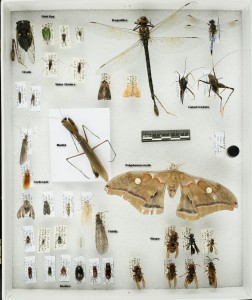 Many people walk through the Forest at NYBG in search of a break from the city and without concern for the names of the trees and flowers they encounter along the path. Others may stop occasionally to watch a passing chipmunk or to photograph the jewelweed. More tenacious individuals, armed with binoculars or perhaps a zoom lens on a camera, will specifically seek out the feathered denizens of the Forest but not many give a second look for the armored creatures that fly past them, the cold-blooded ones that slither under rotting logs, or the nocturnal beings that sit quietly under debris waiting for night to fall.
Many people walk through the Forest at NYBG in search of a break from the city and without concern for the names of the trees and flowers they encounter along the path. Others may stop occasionally to watch a passing chipmunk or to photograph the jewelweed. More tenacious individuals, armed with binoculars or perhaps a zoom lens on a camera, will specifically seek out the feathered denizens of the Forest but not many give a second look for the armored creatures that fly past them, the cold-blooded ones that slither under rotting logs, or the nocturnal beings that sit quietly under debris waiting for night to fall.
However, an effort to catalog these creatures is under way as part of the Garden’s Natural History project. Led by Jessica A. Schuler, Manager of the Forest, and Rob Naczi, Ph.D., Curator of North American Botany, the project has assembled specialists from different fields to identify the flora, fauna, and geography of the many habitats within the Forest.
Read More

 Regular readers of Plant Talk may recall the post I co-wrote during The Orchid Show: Cuba in Flower in March that highlighted the long history and current program of plant exploration in Cuba by scientists of The New York Botanical Garden. Orchids are one of the most diverse of flowering plant families in Cuba, where some 497 species and varieties are known, of which about 181 (36%) are endemic to the island.
Regular readers of Plant Talk may recall the post I co-wrote during The Orchid Show: Cuba in Flower in March that highlighted the long history and current program of plant exploration in Cuba by scientists of The New York Botanical Garden. Orchids are one of the most diverse of flowering plant families in Cuba, where some 497 species and varieties are known, of which about 181 (36%) are endemic to the island.